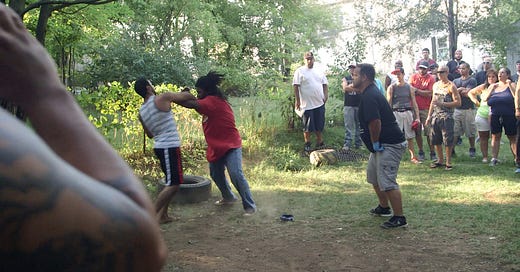Bitch-Ass Nigga
Let’s workshop this poem--dedicated to a hometown friend, Mike Cable--about a good neighbor, both a cultural antiseptic and a cultural probiotic in human form, more needed than ever in our time
scent of the day: Boss Number One (urinal-cake masculinity, baby)
Bitch-Ass Nigga
—for Michael “Chucky” Cable
As young teens swarm
in the bottle-glass street,
the quiet neighbor—
knowing the risks
(group stomping,
police fire), but knowing
the confidence and respect
that can bloom
from male combat—
steps out with boxing gloves,
insisting they come
to his backyard.







"Bitch-Ass Nigga" confronts the realities of street life, male aggression, and the complexities of urban youth culture through the lens of a specific community dynamic. The poem’s focus on a neighbor’s intervention in a potentially violent confrontation underscores a layered examination of masculinity, respect, and conflict resolution. The term "bitch-ass nigga," while harsh and laden with racial and gendered connotations, sets the tone for an exploration of social expectations around toughness, respect, and the male body as a site of power and vulnerability.
In the scene, young teens swarm in the “bottle-glass street,” an evocative image that conjures a sense of urban decay and danger, with shattered glass symbolizing both the literal and metaphorical fragmentation of lives in the neighborhood. These teens are on the precipice of violence, reflective of a larger societal issue where disenfranchised youths, particularly young Black men, often find themselves engaging in physical confrontations as a means of asserting dominance or simply surviving in their environment. The “quiet neighbor” emerges as a figure who understands both the risks involved in such altercations—“group stomping, / police fire”—and the potential positive outcomes that can arise from channeling male aggression into structured physical combat. This neighbor embodies a sense of old-school masculinity, where physical confrontation, if managed within the bounds of sport, can serve as a path to earning respect and fostering self-confidence.
The quiet neighbor’s decision to step out with boxing gloves and invite the boys into his backyard is an act of courage, perhaps even mentorship. It reflects a belief in the transformative potential of controlled combat, where violence is not merely a destructive force but a tool for growth and development. This approach to conflict resolution, however, is not without its complications. The neighbor is aware of the risks inherent in this environment, where police violence is a constant threat, and yet he steps forward, offering an alternative to the chaotic violence that might otherwise erupt. His insistence on bringing the boys to his backyard suggests a desire to create a space where they can safely engage in combat while still adhering to a code of respect and discipline.
The poem ultimately raises questions about the nature of masculinity in such environments. The use of boxing as a metaphor for controlled violence highlights the duality of male aggression: it can be both a destructive force and a means of building confidence and earning respect. In a world where young men are often expected to perform a hyper-masculine role, the quiet neighbor provides a counter-narrative, one that reframes physical combat as a way to develop rather than destroy. The poem thus serves as a meditation on the ways in which communities, particularly Black communities, navigate the complex dynamics of male identity, violence, and respect in the face of systemic pressures like poverty and police presence.
urban masculinity, youth aggression, conflict resolution through sport, controlled violence, respect in Black communities, boxing as mentorship, street life dynamics, hyper-masculine expectations, community intervention, systemic pressures in urban environments.